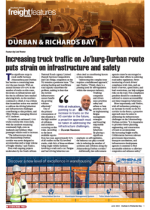The significant surge in truck traffic between Johannesburg and Durban has become a concerning issue over the past decade. With an annual increase of 8-10% in the number of trucks on this route, the strain on infrastructure and the rise in collisions have reached alarming levels. As the numbers continued to climb, it was evident that immediate action was needed to address the driving behaviour and infrastructure challenges contributing to this problem, said Oliver Naidoo, managing director of JC Auditors.Currently, an estimated 7 000 trucks traverse this route daily, with the numbers remaining consistently high, even on weekends and holidays when passenger vehicles tend to increase."The infrastructure along the Johannesburg-Durban corridor was never designed to accommodate such a large volume of freight vehicles," said Naidoo.Even with ongoing projects undertaken by the South African National Roads Agency Limited (Sanral) between Camperdown and Cato Ridge, congestion on the N3 remains a persistent issue. "The existing backlog and insufficient road capacity exacerbate the problem, making it clear that the current infrastructure cannot handle the growing volumes effectively."One of the primary consequences of this situation is the high number of collisions and accidents occurring on this route. According to the latest available reports from last year, approximately 60% of all crashes on the N3 involved trucks, with 62% of these accidents being single-vehicle incidents involving a truck and a car. Fatigue and bad driving behaviour are often cited as contributing factors to these incidents."Addressing this complex issue requires a multifaceted approach," says Naidoo. "Firstly, there is a pressing need for self-regulation within the transport industry. Trucking companies and drivers must prioritise safety and adhere to best practices, such as implementing fatigue management strategies and fostering responsible driving behav iour. By placing a significant emphasis on self-regulation, the industry can play a crucial role in reducing the number of accidents and collisions along the Johannesburg-Durban corridor."Additionally, law enforcement agencies must be encouraged to enhance their efforts in enforcing road safety regulations. Strict monitoring of truck drivers' compliance with rules, such as hours of service, speed limits, and load restrictions, can help mitigate risks on the road. Non-compliance penalties should be consistently enforced to ensure accountability and deter dangerous behaviours.More importantly, said Naidoo, with all indications pointing to an increase in trucks on the N3 corridor in the future, a proactive approach must be taken in addressing the infrastructure challenges on the Johannesburg-Durban corridor. "It is imperative to prioritise better planning, engineering, and construction of roads to accommodate the increasing freight traffic. Collaboration between relevant government departments, transport associations, and infrastructure development agencies is essential to find sustainable solutions to alleviate congestion and enhance safety."

